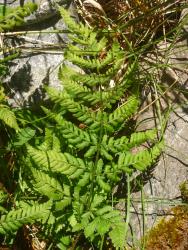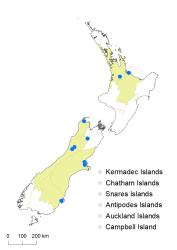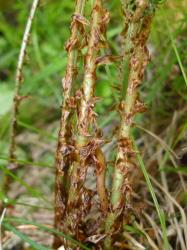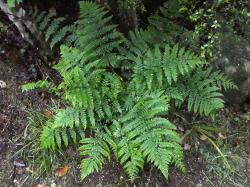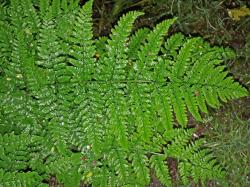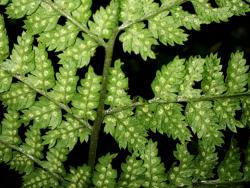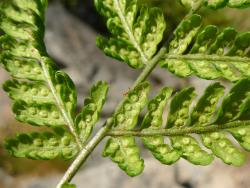- ≡ Polypodium dilatatum Hoffm., Deutschl. Fl. 2, 7 (1796)
Rhizomes erect, densely scaly. Rhizome scales narrowly ovate, 6–12 mm long, 1.5–3 mm wide, dark brown, concolorous or slightly darker centrally, margins entire. Fronds 330–960 mm long. Stipes 150–420 mm long, dark brown proximally, pale brown distally, scaly especially near junction with rhizome; scales ovate or narrowly ovate, dark brown, sometimes with paler margins, often becoming orange-brown distally, up to 20 mm long and 5 mm wide. Rachises pale or yellow-brown, sulcate, narrowly winged distally, scaly; scales scattered throughout, ovate to narrowly ovate, orange-brown or sometimes dark brown, up to 6 mm long and 1.5 mm wide. Laminae 3-pinnate at base, elliptic or ovate, 180–570 mm long, 100–300 mm wide, mid-green on both surfaces, herbaceous, bearing flat scales on abaxial costae, but very scattered adaxially. Primary pinnae in 15–21 pairs below pinnatifid apex, widely spaced especially proximally, narrowly ovate distally, ovate proximally; the longest from middle to base, 60–180 mm long, 30–115 mm wide, apices acute or acuminate, bases stalked; costae narrowly winged for most of their length, not dark at junctions with rachis when fresh. Acroscopic secondary pinnae decreasing gradually in length along the primary pinna to the distal end; the basal basiscopic secondary pinna the longest, narrowly ovate, 19–85 mm long, 10–50 mm wide, apices acute, bases stalked, costae winged throughout. Tertiary pinnae ovate or oblong, 6–32 mm long, 3–20 mm wide, apices obtuse, margins deeply divided into finely pointed ultimate segments, bases adnate, costae winged throughout. Sori present on all pinnae, round, in 1 row either side of costa, nearer costa than margin; indusia reniform, flat when young, 0.5–0.8 mm diameter, concolorous, glabrous.
Dryopteris dilatata is recognised by its erect rhizome with dark brown scales, scaly stipes, 3-pinnate laminae, extended basal basiscopic secondary pinnae on the lowermost pair of primary pinnae, and sori present throughout the lamina (Page 1982; Brownsey & Smith-Dodsworth 2000; Hoshizaki & Moran 2001).
North Island: Auckland, Volcanic Plateau.
South Island: Western Nelson, Canterbury, Westland, Otago.
Altitudinal range: 0–400 m (up to 1550 m).
Naturalised in a few lowland areas around Hamilton and Mt Maunganui in the North Island, and North Westland, Christchurch and Dunedin in the South Island. It mostly occurs below 400 m, but has also been collected from 1550 m at Rainbow Skifield near St Arnaud, where it was presumably introduced by skifield operations.
Occurs naturally in Europe and Asia (Tutin et al. 1964).
Dryopteris dilatata occurs in lowland habitats on pākihi soils, along tracksides and roadsides, on rotten logs, in podocarp forest, under mānuka and introduced willows and pines, and in urban environments. Also recorded from an alpine area near Rainbow Skifield.
Healy (1958). Voucher CHR 53490, CHR 71628, 1950.
No chromosome count has been reported for New Zealand plants. In Europe the plant is known to be an allotetraploid sexual species derived from D. azorica and D. expansa (Fraser-Jenkins 1980).



